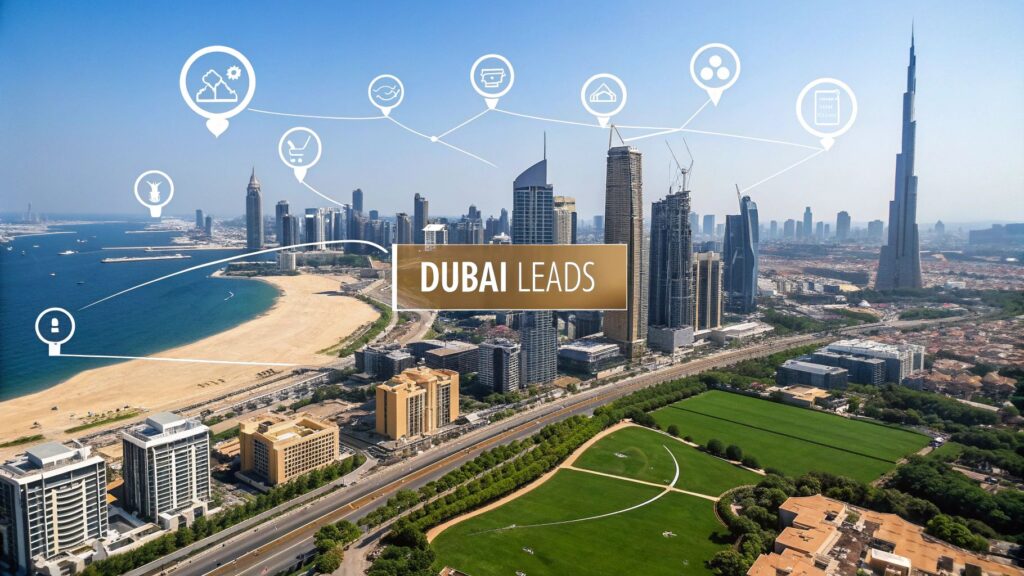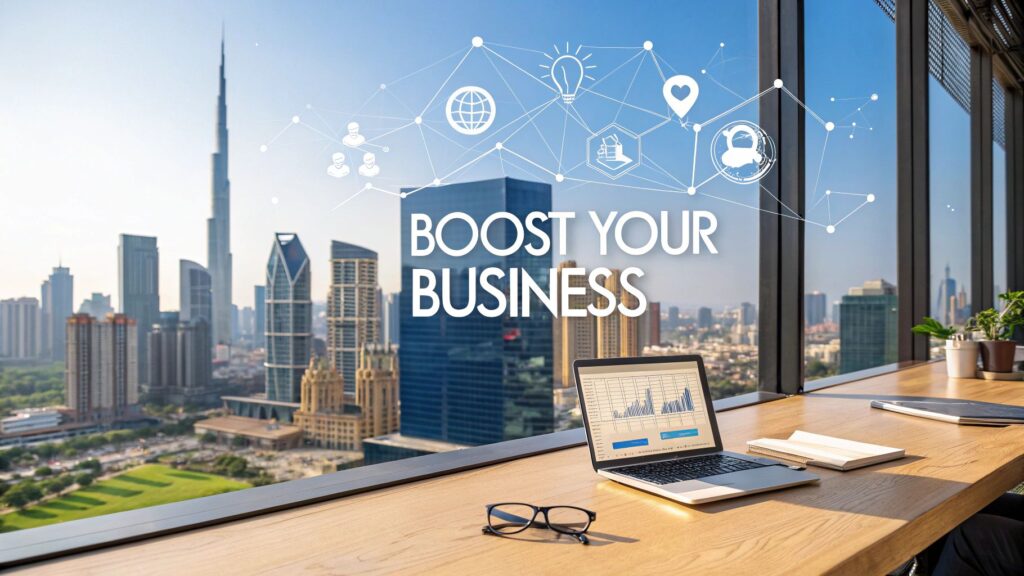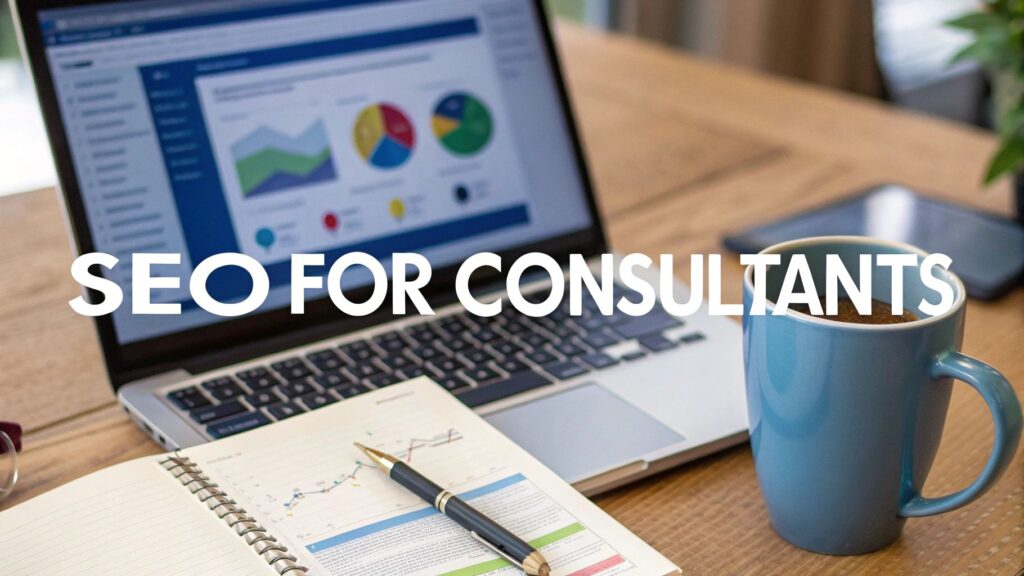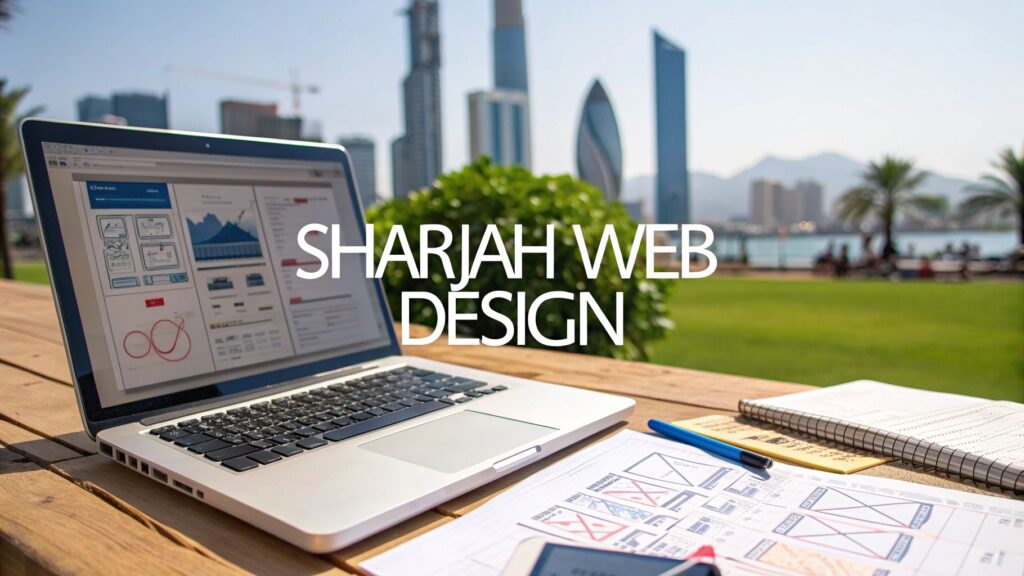Generating leads in Dubai isn’t like anywhere else. It demands a highly localised game plan that mixes digital know-how with a genuine understanding of the city’s unique, multicultural business world. If you try to copy and paste what works in other markets, you’re likely to fall flat. Success here means creating a specific strategy that respects the fierce competition and the diverse audience of over 200 nationalities.
A generic plan just won’t cut it.
Getting to Grips With Dubai’s Lead Generation Landscape

The pace of business in Dubai is relentless. The city’s commercial scene is incredibly dynamic, with over 4,000 new companies launching every single month. Think about that for a moment. This makes it one of the fastest-growing business hubs on the planet.
What this creates is an intensely competitive environment where you have to invest in smart, targeted strategies just to get noticed, let alone capture a lead.
A True Cultural Melting Pot
The single biggest factor shaping business here is Dubai’s population. With residents from over 200 different countries, a one-size-fits-all marketing message is doomed from the start. To be effective, your campaigns need to be carefully segmented to connect with a wide range of cultural and linguistic groups. This means your approach has to be flexible and deeply aware of local nuances.
For instance, a campaign targeting Emirati nationals will need entirely different messaging, imagery, and channels than one aimed at Western expatriates or South Asian investors. Each group has its own unique consumer behaviours, communication styles, and ways of making decisions.
A common mistake I see is simple translation. Real localisation goes far beyond language. It’s about adapting your entire value proposition to align with local values, business etiquette, and what people here actually care about—a process often called ‘transcreation’.
Key Market Characteristics You Can’t Ignore
To build a winning strategy for lead generation in Dubai, you have to get your head around these core market dynamics:
- Sky-High Digital Penetration: The UAE has one of the highest internet and social media usage rates in the world. Digital channels are non-negotiable, but this also means they are incredibly crowded.
- A Mobile-First Audience: Nearly all online activity happens on a smartphone. Your website, landing pages, and ads must be flawless on mobile. No exceptions.
- Relationship-Driven Culture: Don’t let the futuristic skyline fool you; business in Dubai is still built on trust and personal connections. In-person networking, trade shows, and referrals remain incredibly powerful lead sources.
- Fierce Competition: Key sectors like real estate, finance, and tech are saturated. To stand out, you need a crystal-clear unique selling proposition (USP) and a marketing budget to back it up.
Ultimately, your success hinges on blending data-driven digital marketing with an authentic feel for the local culture. Exploring the various services for digital marketing available can give you the expertise needed to navigate this environment. This combined approach is the only way to capture high-quality leads and achieve real growth in this thriving city.
Defining Your Ideal Customer in the UAE
Before you spend a single dirham on a campaign, you need to get crystal clear on who you’re talking to. Having a vague idea of your customer is the fastest way to burn through your budget. Real, effective lead generation in Dubai starts with building a hyper-specific Ideal Customer Profile (ICP) that reflects the unique dynamics of the UAE.
This isn’t about creating those generic buyer personas you might be used to. It’s about getting into the weeds of the demographic and psychographic details that actually drive decisions here. You need to know their nationality, their income level, their cultural drivers, and where they hang out online.
Moving Beyond Surface-Level Demographics
Just knowing an age range and gender is useless in a city as multicultural as Dubai. The gold is in the details that shape how people buy and what they expect from you. For a solid ICP, you need to have answers to questions like these:
- Nationality and Background: Are you targeting Emirati nationals, Western expatriates, or Asian investors? Each group comes with its own set of cultural norms and ways of doing business.
- Professional Standing: What’s their job title and industry? A C-suite executive in DIFC has completely different problems and priorities than a small business owner in Al Quoz.
- Digital Behaviour: What social media platforms do they actually use? LinkedIn is king for B2B, but Instagram and TikTok are where you’ll find most of your B2C audience.
- Cultural Values: What gets them to act? Things like status, convenience, family, and community are huge motivators in this region, but their importance shifts dramatically from one cultural group to another.
We find tools like LinkedIn Sales Navigator are a game-changer for this kind of research. You can slice and dice the data by location, industry, and seniority to build a really detailed picture. And don’t forget to check out local market reports—they often have fantastic data on consumer behaviour you won’t find anywhere else.
Differentiating Your Message for Key Segments
Once you know who your ICP is, you have to speak their language. A generic outreach email or a bland ad will just be ignored. The whole point is to make every interaction feel like it was created just for them.
Let’s say you’re a wealth management firm. Your messaging would need to be completely different for each of these groups:
| Target Segment | Core Message Focus | Potential Channel |
|---|---|---|
| Emirati Nationals | Emphasise legacy, family wealth preservation, and Sharia-compliant investment options. | Relationship-based networking, exclusive seminars, and Arabic-language content. |
| Western Expats | Focus on international investment portability, retirement planning, and tax efficiency. | LinkedIn articles, targeted Google Ads, and professional networking events. |
| Asian Investors | Highlight high-growth opportunities, real estate investments, and Golden Visa programmes. | WhatsApp marketing, multilingual landing pages, and partnerships with local consultants. |
The fundamental takeaway is this: personalisation is not optional in Dubai. If your outreach doesn’t acknowledge the specific cultural and professional context of your ideal customer, it will be perceived as spam. A well-researched ICP is your roadmap to creating communication that connects.
Putting in the work upfront to really understand these distinct groups creates a solid foundation for your entire strategy. That clarity ensures your marketing budget is spent reaching people who are actually interested in what you have to say, which massively improves both the quality and quantity of your leads. This is what separates the campaigns that struggle from the ones that succeed.
Choosing Your High-Impact Lead Generation Channels
Once you’ve got a crystal-clear picture of your ideal customer, the next move is figuring out where they actually spend their time. Pouring your budget into the wrong channels is the fastest way to burn through cash and get nowhere with lead generation in Dubai. The real goal is to create a smart mix of platforms that puts your message right in front of the people who matter, exactly when they’re looking.
This isn’t about being everywhere at once. It’s about being in the right places with a focused, high-impact approach. Let’s break down the channels that consistently deliver results in this unique market.
Dominating Local Search with SEO and SEM
Here in Dubai, when someone needs a product or service, their first stop is almost always Google.ae. If your business doesn’t pop up on that first page for the right searches, you’re practically invisible. That’s why having a strong search presence is completely non-negotiable.
Think about it from a customer’s perspective. A real estate firm isn’t just trying to rank for “apartments for sale.” They’re targeting highly specific, long-tail keywords like “waterfront three-bedroom apartment Dubai Marina” or “off-plan villa investment Arabian Ranches.” These are the kinds of searches that signal serious intent and bring in genuinely qualified buyers.
Your strategy here really has two parts working together:
- Search Engine Optimisation (SEO): This is the long game. It’s all about optimising your website’s content, technical bits, and overall authority so you rank organically. It builds trust and, over time, delivers a sustainable stream of high-quality leads.
- Search Engine Marketing (SEM): This is where you run paid ads (PPC) on Google. It’s the fast track to visibility, letting you jump to the top of the search results almost instantly for your target keywords.
The most powerful approach is to combine both. Use SEM for immediate lead flow and to test which keywords convert best, while your SEO efforts build a long-term, cost-effective foundation. If you’re new to this, you can learn more about what Search Engine Marketing entails and how it can be a cornerstone of your strategy.
Digital Lead Generation Channel Comparison for Dubai
Choosing where to invest your marketing budget in Dubai requires a clear understanding of what each digital channel offers. This table breaks down the primary options, helping you align your strategy with your specific business goals and target audience.
| Channel | Best For | Typical Cost Model | Key Consideration in Dubai |
|---|---|---|---|
| SEO | Long-term, sustainable lead flow; building brand authority and trust. | Monthly Retainer / Project-Based | Highly competitive, but essential for credibility. Local SEO (Google Maps) is critical for service-based businesses. |
| PPC/SEM | Immediate visibility and lead generation; testing keywords and offers. | Pay-Per-Click (PPC) / Pay-Per-Impression (PPM) | High-intent audience, but can be expensive for competitive keywords. Requires constant monitoring and optimisation. |
| LinkedIn Ads | B2B lead generation; reaching specific job titles, industries, and company sizes. | PPC / PPM | Unmatched for professional targeting. The audience expects high-value, professional content, not hard sells. |
| Instagram/Facebook Ads | B2C campaigns; visual products/services (real estate, F&B, retail). | PPC / PPM | Massive, diverse user base. Success hinges on visually compelling creatives and precise audience targeting. |
| Content Marketing | B2B & B2C; establishing expertise and nurturing leads through the funnel. | Content Creation Costs (In-house or Agency) | The Dubai audience is sophisticated and research-oriented. Value-driven content (guides, case studies) builds trust. |
| Events & Networking | High-value B2B deals; building personal relationships and trust. | Sponsorships, Ticket Costs, Travel | Face-to-face interaction is highly valued in the local business culture. Essential for building deep rapport. |
Ultimately, the best strategy often involves a blend of these channels. Start with where your audience is most active and scale from there based on performance data.
Laser-Focused Social Media Advertising
While just having a social media page is fine for branding, paid advertising is where the real lead generation happens. In Dubai, two platforms really stand out for their ability to connect you with the right people.
LinkedIn for B2B Excellence
For any business targeting other companies or professionals, LinkedIn is an absolute goldmine. Its targeting options are incredible, letting you narrow down your audience by job title, company size, industry, and location with pinpoint accuracy. A software company, for example, can run a campaign that shows ads only to CTOs working in Dubai’s financial sector. It’s that specific.
Instagram for High-Impact B2C
With its visual-first approach and massive user base in the UAE, Instagram is the undisputed king for B2C brands. It’s a perfect fit for industries like fashion, hospitality, fitness, and beauty. A luxury hotel could run a targeted video ad campaign promoting a weekend staycation package, aiming it specifically at high-income expats living within a 20km radius.
The Power of Value-Driven Content Marketing
Content marketing is all about pulling leads in by offering them genuine value, not just hitting them with a sales pitch. In a market as savvy as Dubai, potential clients do their homework. They want to see that you’re an expert in your field before they even think about picking up the phone.
This means you need to be creating high-quality, relevant content that speaks directly to their problems and answers their questions.
- For B2B: Think about publishing in-depth whitepapers on industry trends, insightful case studies that showcase real client success, or hosting webinars that offer practical, actionable advice.
- For B2C: Things like engaging blog posts, how-to video guides, and beautiful digital lookbooks can be incredibly effective at capturing interest and building an audience that sticks around.
This approach quietly builds trust and positions your brand as a credible authority, which makes converting those leads down the line a whole lot easier.
The Unbeatable Value of In-Person Networking
Finally, never, ever underestimate the power of a face-to-face conversation. Despite its hyper-modern skyline, business in Dubai is still deeply rooted in personal relationships and trust. Attending industry trade shows, business council events, and local seminars isn’t just a nice-to-have—it’s essential.
These events give you an unparalleled opportunity to connect directly with decision-makers, understand what they need on a personal level, and build the kind of rapport that digital channels simply can’t replicate. A handshake and a good conversation can often open more valuable doors than a hundred clicks on an ad ever will.
Crafting Campaigns That Resonate Culturally
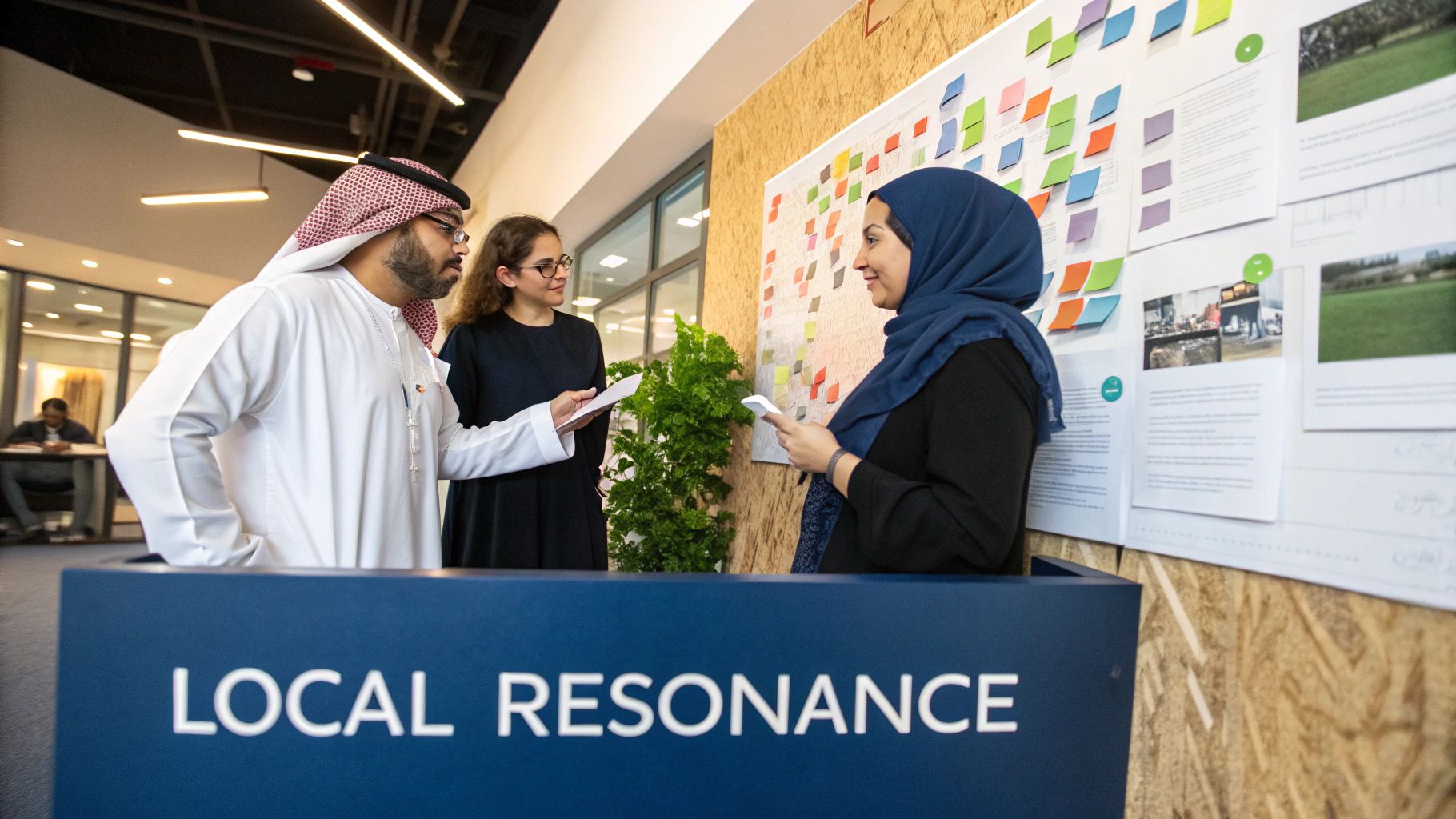
Alright, you’ve picked your channels. Now comes the part where strategy meets the real world—and where many international businesses completely miss the mark in Dubai. Building a campaign that truly connects with the local audience is about so much more than just being on the right platform. It requires a genuine understanding of cultural nuance.
I’ve seen it time and again: companies think a simple English-to-Arabic translation of their existing marketing materials will do the trick. It won’t. This approach is a fast track to failure. Your message, tone, imagery, and even your core value proposition often need a complete overhaul to align with local values and expectations. This is the difference between a forgettable campaign and one that actually drives powerful lead generation in Dubai.
Go Beyond Translation to True Transcreation
The concept you need to wrap your head around is transcreation. Forget simple translation, which just swaps words. Transcreation is about adapting the entire message—the emotion, the intent, the impact—for a new cultural context. It’s about making your brand feel like it belongs here, not like a foreign company shouting from a distance.
Think of it this way: a clever, punchy slogan that works in London might come across as blunt or even disrespectful in the UAE. Imagery that’s perfectly normal in North America could be misinterpreted here. Transcreation is your safeguard, ensuring your brand communicates with relevance and cultural sensitivity.
Localising Your Digital Assets
Your website, landing pages, and social media are your digital storefront. They need to be meticulously localised, and that goes far deeper than just language.
Here’s what you need to nail down:
- Landing Page Imagery: Ditch the generic stock photos. Use images and videos that reflect the incredible diversity of Dubai. Show recognisable landmarks, feature people who look like your customers, and create a sense of place.
- Ad Copy Nuances: Your ad copy has to tap into local pain points and aspirations. A real estate ad shouldn’t just talk about “investment potential.” It needs to connect with deeper desires, like family security, social status, or the appeal of a Golden Visa.
- Social Media Content: Stay on top of local trends and conversations. Acknowledge major cultural and religious events like Ramadan or Eid with tasteful and appropriate messaging.
For example, a European luxury car brand wouldn’t just run its global TV ad here. For the Dubai market, they’d create a campaign showing the car gliding past the Burj Khalifa or navigating desert dunes. The messaging would be all about prestige and performance—two values that hit home in this region.
The goal is simple: when a potential lead sees your ad or lands on your page, their first thought should be, “This company gets me. They get my world.” That instant connection is what turns a click into a genuine conversation.
The Power of a Multilingual Approach
While English is the lingua franca of Dubai’s business world, ignoring Arabic is a massive mistake. At the very minimum, you need a bilingual strategy.
Presenting your core messaging in both English and Arabic is a sign of respect. It shows you’re committed to the market for the long haul, not just as a fly-by-night operation. This is especially critical if you’re targeting Emirati nationals or government entities, where Arabic is often the preferred language for business.
This is where modern marketing tech gives you a huge advantage. Dubai businesses are seeing a massive surge in results—some are generating up to three times more leads than in previous years. This leap is being driven by AI-powered chatbots, highly personalised LinkedIn outreach, and sophisticated multilingual campaigns that connect with the city’s tech-savvy population.
Using AI for Smarter, Personalised Outreach
Trying to manually tailor every message for a diverse audience is a recipe for burnout. This is where AI tools become your best friend for effective lead generation in Dubai. They let you scale your outreach while still making it feel personal and one-to-one.
Here are a few practical ways to put AI to work:
- Dynamic Ad Content: Let AI do the heavy lifting. It can automatically serve different ad versions—with unique images, headlines, and calls-to-action—to different audience segments based on their behaviour and demographics.
- AI-Powered Chatbots: A well-programmed chatbot on your website can engage visitors 24/7 in multiple languages. It can answer FAQs, qualify leads, and provide instant support, ensuring you never miss an opportunity.
- Personalised Email Sequences: Instead of generic email blasts, use AI to create and automate nurture campaigns. It can send highly relevant content to leads based on their specific interactions with your brand, guiding them smoothly toward a sale.
By weaving these tools into your strategy, you ensure every touchpoint is relevant, timely, and culturally on point. This blend of cultural intelligence and technological power is how you create campaigns that don’t just reach the Dubai market, but truly win it over.
Getting Real About Your Lead Generation Budget in Dubai

Let’s be frank: a brilliant strategy for lead generation in Dubai is just a nice idea without a realistic budget behind it. Before we talk tactics, we have to talk money. Understanding the real-world costs is the only way to spend smarter, not just throw cash at the wall and hope something sticks.
The truth is, there’s no magic number. Your budget will be shaped by your industry, how fierce the competition is for your keywords, and exactly who you’re trying to reach. A one-size-fits-all budget simply doesn’t exist in a market as dynamic as this.
To give you a ballpark, the cost per click (CPC) on Google Ads here can swing wildly, from AED 10 to over AED 100. If you’re in a cut-throat sector like real estate or finance, expect those numbers to climb even higher as everyone fights for the top spot. On the other side of the coin, solid SEO work—which is crucial for long-term organic traffic—will typically set you back somewhere between AED 3,000 and AED 15,000 a month.
Splitting Your Budget for Maximum Impact
Managing your budget effectively isn’t about finding the cheapest option. It’s about building a balanced portfolio of marketing activities. You need a smart mix of quick wins and long-term growth strategies to create a lead generation machine that you can actually rely on.
Think of it as dividing your funds between immediate returns and future growth.
- Short-Term Investments (Quick Wins): A good chunk of your budget should go to channels that bring in leads now. This is where Pay-Per-Click (PPC) advertising is king. It puts your brand right in front of people actively searching for what you offer, driving traffic and potential customers from day one.
- Long-Term Investments (Sustainable Growth): The rest should be dedicated to strategies that build valuable assets over time. Content marketing and SEO are the heavy hitters here. They take longer to show a return, but they build your brand’s authority and eventually generate high-quality organic leads for years, all without paying for every single visit.
Your budget allocation isn’t set in stone. Start with an initial split—maybe 60% for short-term and 40% for long-term—but be ready to adapt. If your SEO efforts start pulling in fantastic organic leads, it’s a clear signal to start shifting more of your budget in that direction.
Striking the Right Balance Between Channels
Deciding where to put your money requires a clear head about what each channel does best. Picture it as an investment portfolio, with each channel carrying different levels of risk and reward.
The Role of Paid Advertising
Paid channels like Google Ads and LinkedIn Ads are your accelerators. They give you instant visibility and are perfect for testing new offers, different messaging, and landing page designs. The data you get from a well-run PPC campaign is gold; it gives you quick, actionable insights into what your audience actually responds to. To get the most bang for your buck, it often pays to team up with a specialised PPC advertising firm that knows the ins and outs of the Dubai market.
The Compounding Power of SEO and Content
SEO and content are your long-term wealth builders. When you create genuinely useful blog posts, guides, or videos, you’re not just selling—you’re establishing your expertise and building trust. As that content starts to rank on Google, it becomes a durable asset that consistently attracts qualified leads.
This strategy dramatically lowers your customer acquisition cost over time, making it one of the most efficient ways to achieve sustainable lead generation in Dubai. The only catch? You need patience. The initial investment in creating great content and optimising your site pays massive dividends down the road.
Measuring Performance and Optimising Your Strategy
So, you’ve launched your campaigns. That’s a huge step, but honestly, the real work starts now. Getting your lead generation in Dubai efforts off the ground is one thing; turning them into a predictable, revenue-generating machine is another entirely.
This is where so many companies drop the ball. They set everything up and just let it run, hoping for the best. That’s a surefire way to burn through your budget. The secret to separating the good campaigns from the truly great ones lies in constant, obsessive tracking and intelligent, agile adjustments.
Your focus needs to shift from vanity metrics to the numbers that actually move the needle. Clicks and impressions might look good in a report, but they don’t keep the lights on. It’s time to zoom in on what really matters.
The KPIs You Should Actually Care About
To get a real, unfiltered view of how your campaigns are performing, you need to live and breathe a few core metrics. These are your early warning systems—they’ll tell you if you’re heading in the right direction or if you need to make a sharp turn.
- Cost Per Lead (CPL): This is your raw efficiency score. How much are you paying for every single person who shows interest? If this number starts creeping up, it’s a red flag that something in your funnel—your ad, your targeting, your landing page—is off.
- Conversion Rate: Of all the people who land on your page or see your ad, what percentage are actually filling out that form? A low conversion rate is often a direct symptom of a disconnect between your ad’s promise and your landing page’s delivery.
- Customer Acquisition Cost (CAC): This is the big one. It goes beyond CPL to tell you the total cost to get a paying customer. This is the ultimate benchmark for your marketing ROI and the number your CFO really cares about.
Your toolkit for this is straightforward. Google Analytics is your go-to for tracking website behaviour and conversions. Then, you’ll connect that data inside your CRM, like HubSpot or Salesforce, to see which marketing activities are actually turning into closed deals.
The most common mistake I see is businesses getting distracted by shiny objects. A social media post that gets thousands of likes is great for the ego, but if it doesn’t produce qualified leads your sales team can actually talk to, it’s just noise. Always tie your metrics back to revenue.
The Never-Ending Cycle of Improvement
Gathering data is pointless if you don’t do anything with it. Your analytics should trigger a constant feedback loop of testing, learning, and refining.
Start small with A/B testing. The key is to change only one thing at a time so you know exactly what made the difference. Pit two ad headlines against each other and see which one the Dubai audience responds to. Test a green “Enquire Now” button against a blue one. You’d be amazed at what a difference small tweaks can make.
Use the data to sharpen your targeting. Are you noticing that the leads coming from LinkedIn are closing at a much higher rate than those from Instagram? It might be time to reallocate your budget and double down on what’s proven to work.
Finally, keep iterating on your landing pages. Can you shorten the form from five fields to three? Could you make your value proposition clearer? This relentless process of testing and optimising is what turns a sputtering lead generation effort into a high-performance engine for your business.
Answering Your Top Questions on Dubai Lead Generation
When you’re trying to crack the Dubai market, a few common questions always pop up. Getting these right from the start can save you a lot of time and money, helping you build a lead generation strategy that actually works.
What’s the Best Channel for B2B Leads?
If you’re in the B2B space, LinkedIn is your heavy hitter. There’s no other platform in the region that lets you get so granular with targeting, connecting you directly with the C-suite and key decision-makers at the companies you want to work with.
We’ve found the sweet spot is usually a mix of sponsored content to build brand awareness and direct, personalised outreach using tools like Sales Navigator. But don’t sleep on the old-school methods. Industry-specific events and trade shows are still massive here; nothing beats a face-to-face handshake for building real trust.
How Long Does It Really Take to Get Leads?
This is the million-dirham question, and the honest answer is: it depends entirely on your strategy.
- Paid Advertising: If you need leads now, paid channels are your best bet. A well-optimised Google Ads or social media campaign can start bringing in enquiries within a few days.
- Organic Growth: SEO and content marketing are more of a long game. Think of it as building a valuable asset. You’re looking at a 3–6 month runway before you start seeing a steady, consistent flow of high-quality organic leads.
The smartest play is to run both in parallel. Use paid ads for that immediate hit of leads and market feedback, while your organic efforts build a powerful, cost-effective foundation for the future. This two-pronged approach gives you both short-term wins and long-term stability.
What are the Big Cultural Mistakes to Avoid?
This is where so many international companies get it wrong. Cultural awareness isn’t a “nice-to-have” in Dubai; it’s essential.
First, drop the hard-sell tactics. Business here is built on relationships and trust, not aggressive, high-pressure pitches. Pushing for a close too early is a sure-fire way to alienate a prospect.
Second, pay close attention to your imagery and messaging. Be respectful of local traditions and values. This is especially true during important times like Ramadan, when your tone should shift from overtly commercial to something more community-focused and thoughtful.
Finally, remember who you’re talking to. Your audience is a mix of Emiratis and a huge, diverse expatriate community. If your campaigns only speak to one of these groups, you’re leaving a massive amount of opportunity on the table. Inclusivity is key to successful lead generation in Dubai.
Ready to build a lead generation engine that truly performs in the Dubai market? Invocom delivers end-to-end digital solutions, from strategic SEO and Google Ads to seamless CRM integrations, designed to accelerate your growth. Connect with us to start generating qualified leads.

